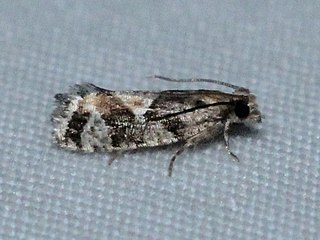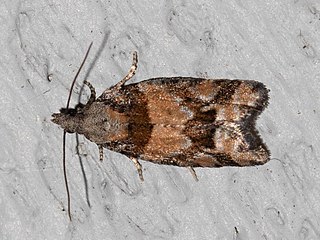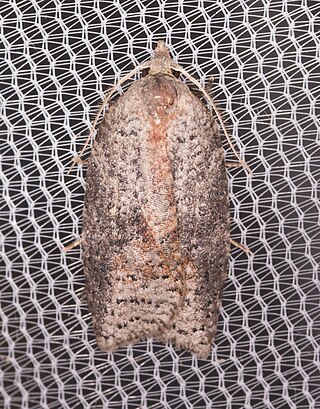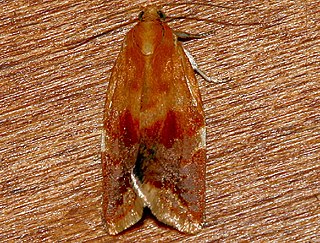
Choristoneura murinana is a moth of the family Tortricidae. It is found in central Europe and the Near East, China, Taiwan and in North America.

Dasychira plagiata, the northern pine tussock or northern conifer tussock, is a moth of the family Erebidae. The species was first described by Francis Walker in 1865. It is found in North America from Newfoundland and Labrador to Alberta, in Massachusetts, New York and North Carolina.

Zeiraphera unfortunana, the purplestriped shootworm, is a moth of the family Tortricidae. It is found in North America in Nova Scotia, from Ontario to British Columbia, Yukon, Alaska, Michigan and Minnesota.

The Zeiraphera griseana, the larch tortrix, is a moth of the family Tortricidae.

Zeiraphera canadensis, the spruce bud moth, is a moth of the family Tortricidae. It is a small brown moth mainly found in North America, specifically New Brunswick, Quebec, and the north-eastern United States. The adult moth flutters quickly, and stays low among trees during the day and higher above tree cover after sunset. The spruce bud moth relies primarily on the white spruce tree as a host plant. Both male and female spruce bud moths mate multiply, however males have the ability to secrete accessory gland proteins that prevent female re-mating. The moth is univoltine, meaning only one generation hatches per year, and its eggs overwinter from July to May. The species Z. ratzeburgiana is very similar to Z. canadensis and can only be distinguished by the presence of an anal comb in Z. canadensis.

Protoboarmia porcelaria, the porcelain gray or dash-lined looper, is a Geometrid species of moth found throughout North America, except in the far north. The species was first described by Achille Guenée in 1857.

Zeiraphera is a genus of moths belonging to the subfamily Olethreutinae of the family Tortricidae.

Gravitarmata margarotana, the pine cone tortrix or pine twig moth, is a moth of the family Tortricidae. In Europe, it is found from England to Austria and Poland, east to the Baltic region to Russia, China, Korea and Japan.

Clavigesta sylvestrana is a moth of the family Tortricidae. It is found in the western and north-western Baltic region, England, France, the Netherlands, Belgium, Germany and Madeira.
Retinia monopunctata is a moth of the family Tortricidae. It is found in Japan, northern China and Russia.

Rhyacionia duplana, the summer shoot moth or Elgin shoot moth when referring to subspecies logaea, is a moth of the family Tortricidae. It is found from northern and central Europe to eastern Russia, China and Japan. It has also been reported from Korea, but it has not been found in recent studies.
Zeiraphera rufimitrana, the red-headed fir tortricid, is a moth of the family Tortricidae. It is found from central Europe to eastern Russia, Mongolia, the Korean Peninsula, China and Japan. It was first recorded from the Netherlands by Kuchlein and Naves in 1999.

Epinotia radicana, the red-striped needleworm moth, is a species of moth of the family Tortricidae. It is found in western Canada, including British Columbia and Alberta.

Amorbia humerosana, the white-lined leafroller, is a species of moth of the family Tortricidae. It is found from the Gulf states to the northeastern United States and southeastern Canada.

Archips strianus, the striated tortrix moth or striated leafroller, is a species of moth of the family Tortricidae. It is found in North America, where it has been recorded from Alberta, British Columbia, Maine, Michigan, Minnesota, Montana, New Brunswick, Newfoundland, Ontario and Quebec.
Argyrotaenia occultana, the fall spruce needle moth, is a moth of the family Tortricidae. The species was first described by Thomas Nesbitt Freeman in 1942. It is found in North America, where it has been recorded from British Columbia north to Yukon and Northwest Territories, east to Newfoundland and south to Kentucky and Oregon. The habitat consists of spruce forests.

Clepsis persicana, the white triangle tortrix or the green needleworm, is a species of moth of the family Tortricidae. It is found in North America, where it has been recorded from Alaska and British Columbia to Newfoundland and south to Virginia and west to California. The habitat consists of coniferous and mixed coniferous forests.
Epinotia aciculana is a species of moth of the family Tortricidae. It is found in China (Heilongjiang), Japan and the Russian Far East.
Zeiraphera gansuensis is a species of moth of the family Tortricidae. It is found in China.

Acleris abietana, the Perth button, is a species of moth of the family Tortricidae. It is found in Europe, where it has been recorded from Great Britain, Ireland, France, Belgium, the Netherlands, Germany, Denmark, Austria, Switzerland, Italy, the Czech Republic, Slovakia, Slovenia, Poland, Hungary and Russia. The habitat consists of coniferous woodlands.














